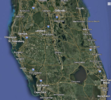Nerman
Member
GFS & Euro landfall tracks now appear to be in line with the Euro just getting there faster
And weaker. Cloud top's are warming compared to this morning. It's obvious Ian's having structural difficulties now.Gfs with a jump east
View attachment 122320
It’s going through an ERC. This is to be expectedAnd weaker. Cloud top's are warming compared to this morning. It's obvious Ian's having structural difficulties now.
I’m not sure what to think with the inner eyewall regenerating and the moat filling in.
Trend is faster for sureView attachment 122322
Quite the trend
The center goes into Tennessee on this run.Trend is faster for sure
Yep. After it stalls out over NW SC and WNC for about 18 hoursThe center goes into Tennessee on this run.
Very similar to the 12z Euro. Also, the pressure at the SC landfall is 988mb still probably a low end category 1.Quite the trend

That's amazing
Eyewall replacement cycle has been going on.Whatever Ian is doing, either be it EWRC or burping out dry air, recon found 949 w/ some wind, so intensification may not have halted…
947 mb.SUMMARY OF 700 PM EDT...2300 UTC...INFORMATION
----------------------------------------------
LOCATION...24.3N 83.1W
ABOUT 200 MI...320 KM SSW OF PUNTA GORDA FLORIDA
ABOUT 30 MI...50 KM SSW OF THE DRY TORTUGAS
MAXIMUM SUSTAINED WINDS...120 MPH...195 KM/H
PRESENT MOVEMENT...N OR 10 DEGREES AT 10 MPH...17 KM/H
MINIMUM CENTRAL PRESSURE...947 MB...27.96 INCHES
I mean good god! Latest HWRF now has strengthening IAN into the 920s… these models do the best the closer we get to a land falling event .. this is concerning View attachment 122328

Let’s remember though, this would not have happened this close to landfall had the storm stayed a little west and gone in at the Big Bend or Panhandle like things looked a couple days ago. The conditions at this latitude were always going to be conducive for major strengthening. With it taking the path it’s taking, the area of strong shear might actually being aiding it allowing the storm to vent and have a strong outflowNot surprised. This is what I was saying a few days ago. These things have blown up like crazy in the Gulf the past few years.
Yep. Last run of the Euro has the anticyclone on top of the system until landfall at this track.Let’s remember though, this would not have happened this close to landfall had the storm stayed a little west and gone in at the Big Bend or Panhandle like things looked a couple days ago. The conditions at this latitude were always going to be conducive for major strengthening. With it taking the path it’s taking, the area of strong shear might actually being aiding it allowing the storm to vent and have a strong outflow
